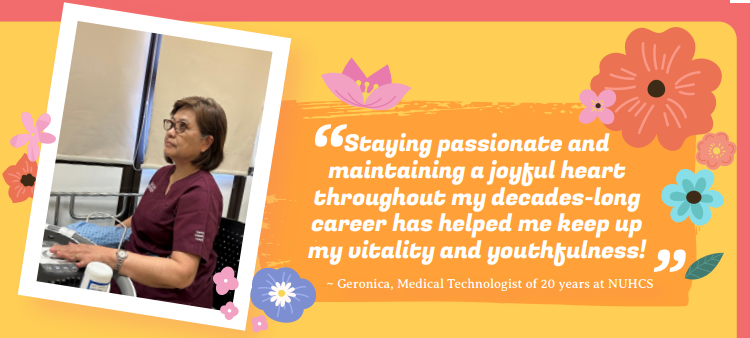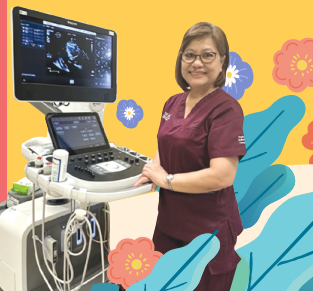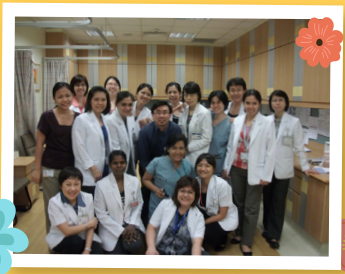Amplifying The Love For Echocardiography
Honouring 20 years of service in heart imaging
PULSE Issue 43 | July 2024
As a Senior Medical Technologist at the National University Heart Centre, Singapore (NUHCS), Geronica’s two-decade-long
career is a testament to Socrates’ famous quote. In addition to inspiring co-workers with her strong technical expertise and
investigative skills in echocardiography1, the veteran professional has also cultivated a deep understanding of the human
side of healthcare, touching countless patient lives in the process.
As Geronica looks to embrace her next chapter of retirement, the PULSE Editorial Team
catches up with the sprightly 68 year-old to learn more about her remarkable journey as
a cardiac medical technologist, what keeps her heart for echocardiography beating, and
her unique perspectives at the past, present, and future of this exciting field!

Share more about your career journey, and what inspired you to pursue the field of echocardiography?
Geronica: I've always been intrigued by the human anatomy, and this curiosity led me to explore the world of medical imaging2
. After
completing my education and training, I practiced as a medical technologist in various countries such as the Philippines and Saudi
Arabia. I eventually settled in Singapore and NUHCS appealed to me with its diverse and collaborative environment, where I could
combine my passion for healthcare and technology to make a meaningful impact.
Could you walk us through a typical day as a cardiac medical technologist at NUHCS?
Geronica: Each day brings a unique set of challenges and opportunities. First of all, my role involves performing ultrasound scans, capturing
images to accurately assess the heart’s structure and function in situations where heart disease is suspected or known, to help classify heart
failure and guide treatment.
Besides preparing and operating the ultrasound equipment to ensure my patients receive the highest quality of care, I also collaborate
closely with the cardiologist, or research personnel and other staff, to resolve issues and provide insights, wherever cardiovascular diagnostic
procedures or equipment are concerned.
 What are some of the challenges you face in your role, and how do you overcome them?
What are some of the challenges you face in your role, and how do you overcome them?
Geronica: One of the challenges we face is dealing with patients who may be anxious, upset or in pain. As patients and their family
may come to us with some degree of anxiety due to the possibility of a heart problem, it is important to set a calming tone to help them
understand what they need to go through and ensure that they feel comfortable before and during the procedure.
Interpreting ultrasound images accurately can sometimes be complicated, especially in patients with unique anatomical variations. Having
a mindset of continuous learning, even after many years on the job, helps me to navigate any challenges.
Could you share some of the rapid advancements in medical technology; how do you stay updated
in this ever-evolving field?
Geronica: Advances such as better image quality and more sophisticated diagnostic capabilities have made waves in the world of
medicine. I attended workshops, conferences, and training programmes to stay abreast of the latest innovations and techniques in the
field, so I can further enhance the quality of care I provide to patients.
Apart from your routine work at NUHCS, do you also engage in educating and mentoring?
Geronica: Yes, I enjoy sharing the knowledge and experiences I have gained across different modalities with the doctors and my fellow
medical technologists. I believe that it is paramount to nurture the next generation to instill in them the confidence, compassion, and
a commitment to excellence in echocardiography. Empowering myself by staying active, and preparing teaching materials for my
students, further allows me to value-add to the knowledge depository.
What do you feel are the essential qualities for a career as a cardiac medical technologist?
Any advice for those keen to enter the field?
Geronica: To excel in echocardiography, one must have a strong foundation in the human anatomy and physiology, and attention
to detail. Equally important are excellent communication skills, compassion and patience, when working with patients, who may be
going through a difficult time.
Stay committed to lifelong learning, and cherish the relationships you build with patients and colleagues. This field will not be
stagnant and will only continue to evolve, but your dedication and passion for echocardiography will keep you moving forward.

Lastly, could you share what you will miss most
following your retirement?
Geronica: The daily interactions with patients, the thrill of solving
diagnostic puzzles, and of course, the camaraderie at NUHCS! I am
immensely thankful for the amazing support from all my colleagues at
NUHCS throughout my years here!
1. Echocardiography – A painless and non-invasive ultrasound test
to visualise the heart’s structures, for diagnosing issues such as
enlargement of the heart, structural abnormalities, blood clots, etc.
2. Medical Imaging – Use of technologies to take pictures of internal
areas of the body to guide diagnosis and treatment.
